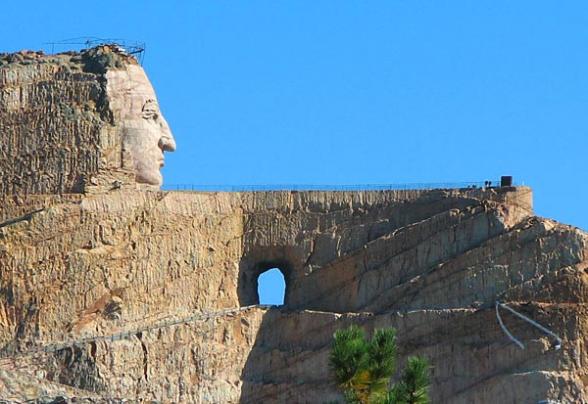
The monument commemorates Crazy Horse (circa 1840-1887), an Oglala Lakota war leader who had been well-respected by his people. He directed victorious fights against many of his tribe’s enemies, including (but not limited to) the Blackfoot, Crow, Pawnee, Shoshone, and US forces.
One well known battle involving US troops was the Battle of the Rosebud in Montana Territory. In June of 1876, Crazy Horse led a group of 1,500 Lakota and Cheyenne in a surprise attack against Brevet Brigadier General George Crook’s force of US footmen, cavalry, and Crow and Shoshone warriors. The following battle was a draw, with the sides having roughly equal losses.
However, the battle delayed Crook’s troops from meeting Lieutenant General George Custer’s troops at the Battle of Little Big Horn. This contributed to the subsequent “Custer’s Last Stand” in which Custer was killed and the Lakota-Cheyenne alliance emerged as victors.
After decades as a valiant warrior, Crazy Horse finally surrendered to the United States in May of 1877. His people were weakened by hunger and a cold Nebraska winter.
Crazy Horse and his allies formally surrendered at the Red Cloud Agency, which was a precursor to Indian reservations. After Crazy Horse had been living on agency property for a couple of months, it seems that his words were mistranslated by a US Army scout. An ensuing argument led to Crazy Horse’s death by bayonet stabbing on September 5, 1877.
His parents moved his body to an undisclosed location. The monument was requested by Chief Henry Standing Bear of the Oglala Sioux. In
1939 he wrote to the sculptor Korczak Ziolkowski, who was known for chiseling Mount Rushmore. His letter included the request, “My fellow chiefs and I would like the white man to know that the red man has great heroes, too.”
Ziolkowski decided upon Crazy Horse, and by 1943 the monument was underway. The site: eight miles from Mount Rushmore, and five miles from Custer. Since the original artist’s death, the project has been overseen by his wife Ruth Zioljowski and several of their children.
A milestone in carving was reached in 1998 when Crazy Horse’s face was completed. The next step requires shaping the head of his horse, which is accomplished with very precise explosions of dynamite.
The horse’s head will include ridges to be used as access roads for trucks hauling rock away.
Progress has been hindered by the project’s non-profit status. The Crazy Horse Memorial Foundation rejects federal funding because they have plans beyond the monument itself.
The sculpture is part of a larger vision for Crazy Horse Memorial, which already includes an Indian Museum of North America and a Native American Cultural center.
The foundation also seeks to establish and fund the University and Medical Training Center for the North American Indian. The foundation’s many goals are supported mostly with cash from visitors, who number about a million each year.
Although some people see the mountain carving as a great tribute to Native Americans, others disapprove. They say that altering nature in this way is contrary to what Crazy Horse would have wanted.
Related Sites On:
Best American Tourist Attractions
No comments:
Post a Comment